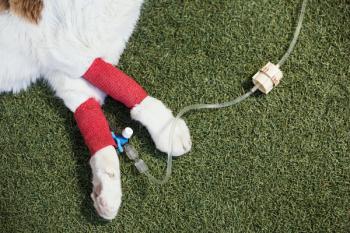
Day-to-day steps to help your practice
Your veterinary team knows all about the health of your patients, but what about the health of your veterinary practice? In this Team Meeting in a Box, you'll look at the condition of your financials and your operations and then treat them with new ideas and strategies. Remember, the more successful your practice is, the better it will be for your team, clients and patients.
Welcome to Firstline's Team Training in a Virtual Box, your complete guide to team training. Each lesson is designed to give you all the tools you need to plan an educational staff meeting on a single topic. This lesson plan will examine day-to-day steps to help your practice, including ways that team members affect the financial health of the practice. In each section, you'll find an introduction, a list of discussion points, and teaching tools and handouts to help you educate your team.
Click the headlines below to access the meeting tools.
Press the links below to access the meeting tools.
Part 1: Team knowledge
Your veterinary team knows all about the health of your patients, but what about the health of your veterinary practice? The more your team learns about clinic revenue, inventory, expenses and so on, the more they can help contribute to the overall success of the practice. Use this meeting to educate your team and explain why running a veterinary practice is not a cheap operation. Discuss the overhead costs and everyday solutions that can help keep these costs down.
Part 2: Implementation
In this section, your team will take time to brainstorm and discuss what new ideas they have for the practice. Help them understand the process of presenting a new idea or suggesting an improvement for an existing procedure.
Part 3: Client communication
There's no such thing as too much client communication. This part of the meeting will help ensure everyone in your practice understands how to effectively communicate with clients and the importance of being advocates for preventive care and being conversant about your practice's payment options.
Part 4: Marketing and follow-through
Your team has talked through many practice issues and come up with great solutions to help your practice-but what's next? It's time to create an action plan using your new Goal Tracker to make sure these great ideas don't get lost in the daily shuffle. Be sure to set deadlines and revisit these goals often.
Part 1 resources
Download these handouts and tools before your team meeting:
Part 1: Team knowledge
Your veterinary team knows all about the health of your patients, but what about the health of your veterinary practice? We're talking about clinic revenue, inventory, expenses, and so on. The more your team learns about these numbers, the more they can help contribute to the practice's overall success. (Before you start, download the
Use this meeting to teach your team why running a practice isn't a cheap operation. Discuss the overhead costs and everyday solutions to help keep these costs down. For example, it sounds corny, but turning lights off when you leave an exam room really is an easy way to cut down on the electricity bill. (Your mother was right after all! You can thank her later.)
5-minute discussion: The cost to keep the lights on
Start the discussion by asking your team, “What are some of the expenses that go into running our veterinary practice?” Nominate a team leader to record the responses on a whiteboard or large poster board at the front of the room. After a few minutes of brainstorming, hand out the Financial worksheet team training tool so your team can see a quick overview of the clinic's daily expenses.
After you talk briefly about each expense, you can start setting some SMART (Specific, Measurable, Achievable, Resultsfocused, and Time-bound) goals for the practice. These goals can focus on attracting more clients, reevaluating service discounts, and more. Don't forget to follow-up on these goals at every team meeting.
Wrap up the discussion by reminding your team that there are two ways for the business to earn more profit: reduce expenses and increase revenue. Make sure they know that you can't run a successful practice without their help and input.
Consider offering rewards, such as extra hours of personal time off or complimentary lunches, for effective solutions and suggestions on how to save the clinic money, time, or resources.
3-minute activity: What are wellness plans?
One way to help improve the health of your patients and your clinic is to consider offering wellness plans to your clients. If you have yet to roll out these preventive care plans, then your team probably has many questions. How much do they cost? What's covered under the plan? How will they explain them to pet owners?
Distribute the two team training tools: What about wellness plans? and Team talking points: Wellness plans. Allow the team to read and fill out the tools. Then use these activity sheets to review the components in a wellness plan, answers to clients' common questions about wellness plans, and ways these plans can boost the level of regular and preventive health care patients will receive each month.
Conclude your meeting by thanking team members for their time and attention. Remind them that next time you'll talk about generating new ideas for the practice and the importance of goal-setting.
Part 2 resources
Download these handouts and tools before your team meeting:
Part 2: Implementation
In Part 1 of your meeting, you discussed the cost of running a practice and how wellness plans can help keep your patients
and practice healthy. Next, help your team understand the process of presenting a new idea or suggesting an improvement
for an existing procedure. After all, you can't evolve the practice without their creative input and thinking caps.
3-minute activity: Hey, what's the big idea?
It's no secret that the veterinary industry is changing every day. That's why it's so important to encourage your team to
brainstorm new and exciting ways to stay relevant and ahead of the curve when it comes to veterinary care. But once that
great idea strikes, then what?
Introducing the
During the meeting take a minute and ask, “Does anyone have an idea for the practice they'd like to share now?” Then you can work through the flowchart together as a group, so everyone can see the process in action.
5-minute activity: Setting and tracking goals
For this next activity, divide your team into small groups. Try to make sure each group has a diverse mix of people and positions in the practice. Invite each group to come up with one goal for the practice-for example, increase the number of pet owners who opt for a wellness plan. Then turn this goal into a SMART goal (Specific, Measurable, Achievable, Results-focused, and Time-bound).
These objectives can be recorded and updated in the
Part 3 resources
Download these handouts and tools before your team meeting:
Part 3: Client communication
In Part 2, your team learned how to generate ideas and set measurable goals for the practice. Now it's time to communicate what you've learned. This part of the meeting will help ensure everyone in your practice understands how to effectively communicate with clients and the importance of being advocates of preventive care and payment options.
By the end of the meeting, each team member should be able to explain the difference between wellness plans and pet insurance without skipping a beat.
3-minute activity: Front Desk Disasters: Show Me the Money
Never underestimate the power of your front desk staff. They are the first and the last people your clients see every day. And making sure pet owners leave on a high note after they receive their veterinary bill is no easy task. This is why every customer service representative should be able to explain and add value to the numbers on every receipt.
Want to see what not to say? Show your team this short video clip where Rhonda the receptionist completely flubs how she presents a bill to clients. Then go around the room and call out all of the receptionist's mistakes. Discuss as a team a better approach to presenting a bill and discussing payment options with Ms. Douglas.
5-minute activity: By the numbers
It makes sense that clients who use tools such as pet insurance and wellness plans typically spend more, but is there any data to support these claims? Hand out the following worksheets and invite your team to see how other practices are benefiting from the different plans.
•
•
•
After you read and discuss the handouts, the team should see that these plans mean better health for pets and better financial health for the veterinary practice. Explain to your staff that the more successful the practice is, the better the chances are for team pay raises, promotions, and year-end bonuses.
This concludes part 3 of your meeting on communication with clients about pet insurance and wellness plans. Thank team members for sharing their ideas and for their participation. Remind them in the next meeting you'll put all of the pieces together to create a marketing and action plan for implementing these services in your practice.
Part 4 resources
Download these handouts and tools before your team meeting:
Part 4: Marketing and follow-through
Pre-meeting Activity Guide
Please note: Before you engage in Part 4 of the Team Meeting, we strongly recommend that you complete the following exercise with practice owners and managers in your practice. This will prepare your team for more effective discussions.
Pre-meeting activity: Self-test to rate your management style
Give practice owners and managers a chance to reflect on their day-to-day practices with the
Schedule a special follow-up meeting so owners and managers can come together and discuss their clinic priorities as a
group.
Meeting Guide
Congratulations on completing Parts 1, 2, and 3 of your meeting. You've shared tools to help team members become educated about day-to-day steps to help your practice, your team, and your patients. In this final section, you'll compare the costs of treatment versus preventive care and make a plan for tracking your clinic goals.
Team Activities: 5-minute activity: 3 common diagnoses
In 2013, Veterinary Pet Insurance Company (now Nationwide) policyholders spent more than $66 million treating the 10 most common medical conditions affecting their pets.* As you know, many of these conditions could have been prevented with regular examinations and preventive care.
Divide your team into three different groups. Distribute copies of your practice's fee schedule and the handout
2-minute activity: Recognize and reward success
Your team has talked through practice issues today and come up with great solutions to help your clinic-but what's next? It's time to create an action plan to make sure these great ideas don't get forgotten in a week. Nominate a leader to keep track and update your goals on the
To motivate your team, don't forget to celebrate! Choose a reward that's meaningful to your team-it could be a pizza party, a team activity (such as a bowling night), or tickets for a drawing for gift cards for the local coffee shop or favorite store. The more excited they are, the harder they will work toward your goals.
3-minute activity: Management self-test
Give your team a chance to complete the Self-test: Rate your management style training tool that the practice owners and managers completed earlier. This will give you a chance to see whether your team members see things the same way.
Conclusion
To close your meeting, give yourselves a pat on the back. You've made a lot of recommendations in four short meetings. And soon your practice will start reaping the benefits and your clients-and patients-will thank you.
*Source:
Newsletter
From exam room tips to practice management insights, get trusted veterinary news delivered straight to your inbox—subscribe to dvm360.



